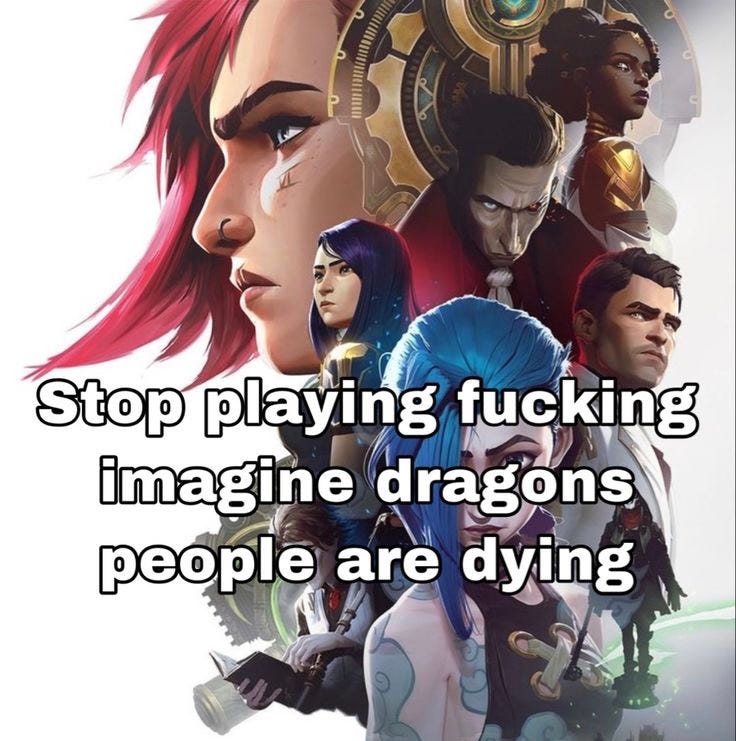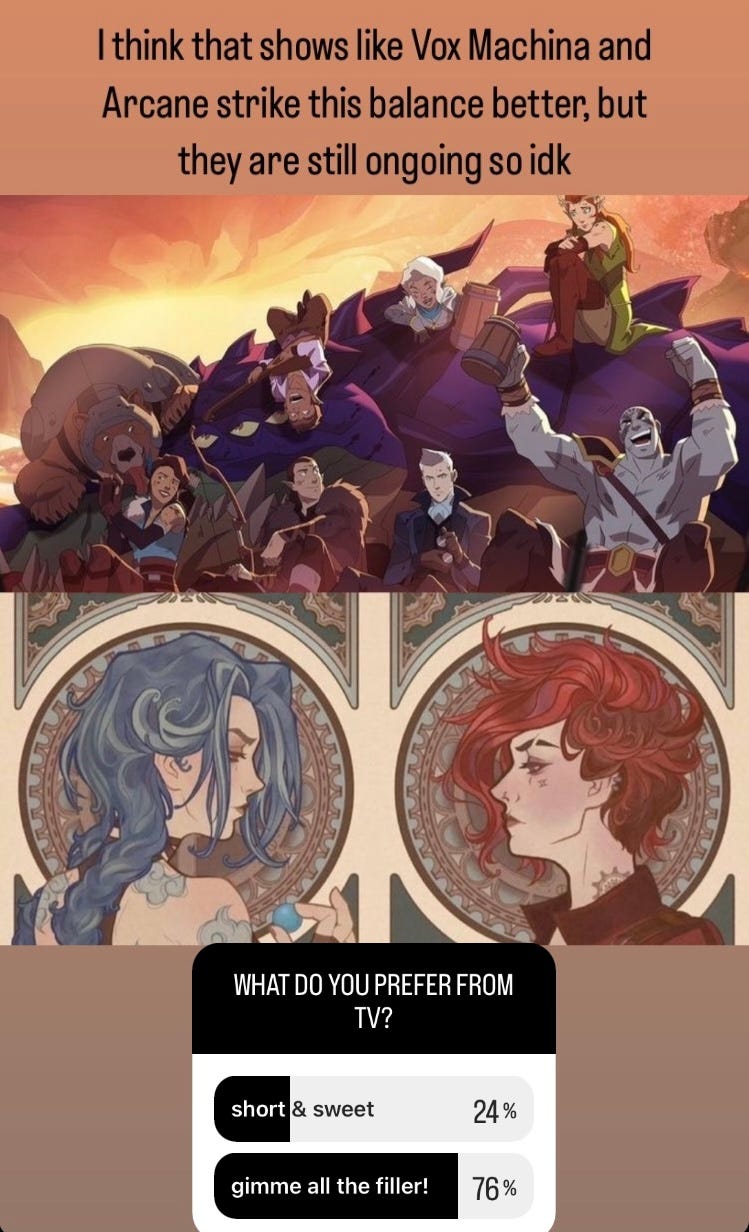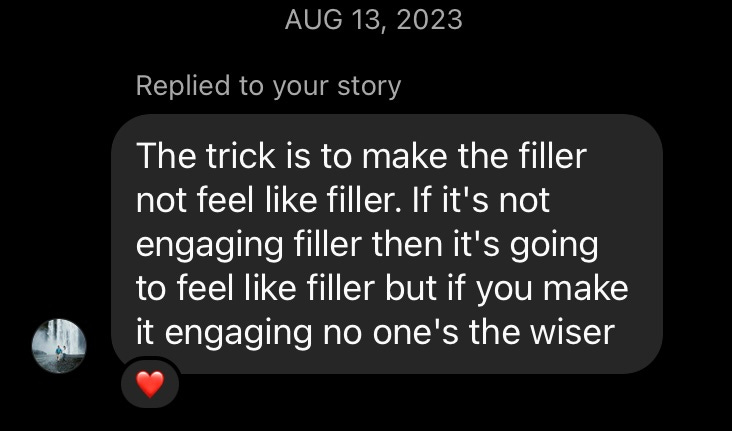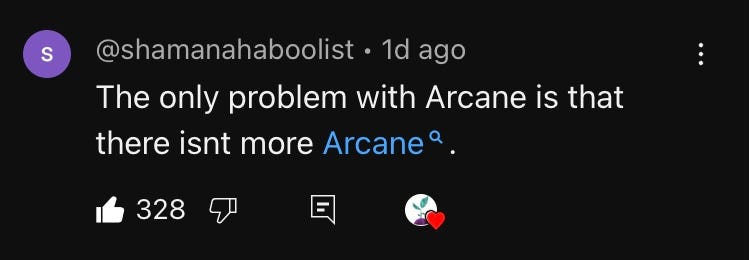Intro, yo
Television is one of my favorite mediums of storytelling—second to only books, and only sometimes. Movies can get kind of formulaic for me and aren’t long enough to be sufficiently immersive over a long period of time. Theater is fun but also has its medium restraints. You can only do so much on a stage with real people in real time. Graphic novels and manga lack the beautiful prose that I enjoy so much in books, and video games feel like a liminal space between storytelling and something else. This isn’t to say that I don’t enjoy all forms of storytelling—I absolutely do, but ever since I watched ABC’s Lost as an impressionable 14-year-old, the medium of television has cemented itself in my heart as one of my favorite ways to engage with stories.
Which is why I’m so damned disappointed in the most recent season of Arcane.
For some context, I adored season 1. I thought it was a perfectly paced masterclass of visual storytelling with a multitude of interlocking story elements that built upon one another. Not only was season 1 a visual treat, it was rich with queer normativity, chronic illness/pain representation, and diverse characters. The only thing that held it back from being an S-tier show for me was the . . . well, musical stylings of one Imagine Dragons. Personally, it really broke the immersion. One moment we were in this highly stylized, steam/cyberpunk fantasy world. The next it was a 2014 tumblr edit of “Demons.”
I digress. Point being, I love season 1 of Arcane. I wanted to love season 2. Let’s get into it.
History of TV as a Medium Taken Seriously
When discussing this topic, I always like to say: “Lost walked so Breaking Bad could run.” What this means is, Lost—the hit 2004 science fantasy show about survivors who get stranded on a mysterious island—broke through as a TV show that could be on par with cinema as a genre. Suddenly, television could deliver the same dramatic scope and scale that movies could—but even better because there were hundreds of hours of it. Fans were along for an experience that lasted years, there were endless details to pick apart and analyze. No longer was television merely rinse-and-repeat sitcoms or campy villain-of-the-week pulp. (Caveat: this type of TV isn’t always bad, it just serves a different purpose than shows like Lost and Breaking Bad.) Television held a giant, flaming torch to the movie industry, pioneering with high budgets, deep, complex storytelling, and cinematic craft. Breaking Bad came along and perfected what Lost had started, with not only action-packed seasons, but characters crafted with care and genuine storytelling elements that enabled a story to be told over multiple episodes and seasons. Visual storytelling exceeded the bounds of traditional cinema, with shows being green-lit for several solid seasons, each with approximately 12-20 episodes, anywhere from half an hour to 50 minutes.
Fast forward not one but two writer’s strikes later, and the landscape of television has changed. With the rise of streaming services, I’ve noticed a trend. Seasons are getting shorter. Good, quality shows that would have gotten 15 episodes a season and a 4-season package are now getting 8 episodes and maybe 2-3 seasons. Granted, I understand why this is, both from a storytelling perspective and from a capitalist leech perspective. On one hand, sometimes shows did get a little too drawn out. Sometimes you could smell the writer fatigue through the screen. On the other, longer shows probably don’t make as much money, when you’re spending quite literally millions on each episode with no guarantee of profit. These days, television is leaner and meaner due to corporations analyzing the formula and attempting to, as the gamers might say, min-max. Minimize loss via time and money, maximize viewership via ads and shorter shows for short attention spans. However, Reddit user HelsSoWeird20 says on r/screenwriting:
“TV is starting to lose the thing it had over movies: flexibility. No filler episodes means less time to develop a relationship with the characters, and season-long arcs have to be more rushed.”
(Yes, I’m quoting Reddit now, I’m not in college so I can cite whoever the fuck I want.) I had this same complaint with season 1 of The Last of Us. On August 13th, 2023, I posted to Instagram a series of stories based on a conversation I had with my partner Welby on why television just doesn’t hit the way it did in the 2000s and 2010s. It’s because production companies no longer allow shows to meander.
HBO’s The Last of Us is undeniably good. It’s got high production value and stays very consistent with the story of the original game. But since it’s 2023 and HBO, it has to be 9 tight, clean, high-production episodes. But here’s the kicker: you can easily spend 50+ hours playing through the original video game. Distilling it down to 9 hours feels like a crime because a part of the joy is how much time you get to spend with Ellie and Joel. A good video game adaptation not only follows the source material of the original, but it also has to capture the spirit of what it’s like to play the game. While I have the same storytelling gripe of Amazon Prime’s Fallout adaptation, what it has over TLOU is that it captures the spirit of what it feels like to play Fallout 3 or Fallout 4.
Okay, but how does all of this relate to the newest season of Arcane? Well, in that same series of Instagram stories I made in 2023, I wrote:
Unfortunately, I stand corrected. Season 2 of Arcane is a beautiful mess running at 100 mph and snorting cocaine. And it seems my Instagram followers agreed with me. But even to this day, I still think people misunderstand what “filler” is in the context of Western shows. Filler is an anime term that denotes content that is not “manga canon.” You can watch it if you want, but you won’t lose anything by skipping it. What people call “filler” these days is actually just character development and world building and proper pacing. Instagram user @sterlingmzwrites responded to my stories and said:
So now that I’ve identified what I think the problem is with season 2 of Arcane, let’s break it down.
The Pacing of Character Arcs
When I first started thinking through my criticisms of season 2 thus far, I originally thought it was the pacing of the show in general. However, Arcane season 1 is also pretty fast paced, all things considered, and I think it works. No complaints there. So why doesn’t it work here?
As I was gathering my thoughts and others perspectives on season 2 thus far, I watched My Little Thought Tree’s video on the topic, titled “there’s only ONE thing wrong with Arcane S2 Act 2” and was enlightened. He makes the claim that it’s not necessarily the pace of the plot, it’s the pace of the character arcs. Emotional moments are not allowed to breathe. Character decisions are not allowed to have actual consequences. For example, @razorbladecactus on TikTok puts it beautifully:
“given how obviously drastic Vi’s six-month downward spiral has been, we’re not given anywhere near enough time to process that or see it through as part of the story before it no longer matters.”
Season 2, episode 5, “Blisters and Bedrock” begins with a 2-minute long montage of pitfighter Vi, who is balls-deep in alcoholism and who has a trademark “mental-breakdown hair dye” look. (I can comment on it like that because I’ve done it.) With a show that has such beautiful and detailed character design, changing Vi’s iconic pink hair and default outfit indicates a fundamental change in her character. But how has Vi truly changed between Acts 1 and 2? Given that Jinx shows up and convinces Vi to get her shit together and Vi kisses and makes up with Caitlyn ONE SINGLE EPISODE LATER, we the audience never really get to feel the impact of Caitlyn’s betrayal and the devastation of Vi fighting Jinx yet again from Act 1. It never has a chance to solidify in our emotional viewing experience because what’s supposed to be a defining character change for Vi comes and goes in a single 2-minute montage. This is not a criticism of the content of Arcane at all; the story they’re working with is good material, but like any good hunk of meat, you gotta let it marinate. Like any good soup, you gotta let it simmer. We all know food is all the better and richer for it. Same goes for stories. As TikTok commenter @zephrynatrinity says: “Montages can do a lot but they can’t carry the weight of character development.”
In the My Little Thought Tree video (I’m sorry I couldn’t find the creator’s first name on the internet), he says:
“Vi starting at rock bottom and then ending in Vander’s arms. [ . . . ] That’s a good progression that you can fit into one episode. What doesn’t work so well is the beats we get along the way to reach that. [ . . . ] I love the montage at the start. [ . . . ] I think they’re a great tool to express changes in time, but sometimes it is also a hindrance because we don’t really get to sit with the emotion for a long time. We get a very dynamic experience of the feeling, but not time afterwards to reflect and to process or even just to have characters talk about it. [ . . . ] [The montage is] a great way to set up where Vi is in her life now, but I think it should be that: a set-up to it, not the entirety we see of that before moving on to a different Vi. [ . . . ] The reason it feels fast isn’t because of pacing itself; it’s because it’s hard to buy into this change.”
He hits the nail on the head about the montage. However, where my analysis diverges from My Little Thought Tree’s is that I think the problem he’s describing is still ultimately about pacing. The pace at which events happen, whether that is fast or slow. The decisions a creator makes on what to show and what not to show and when. What he’s describing is not necessarily the pacing of the plot, but the fast pacing of the character arcs leading to very obvious gaps. Little Thought Tree is correct in saying that there are integral character beats missing from Vi’s Act 2 spiral, which leads to an audience experience of emotional whiplash. A story missing character/plot beats is still makes for bad pacing.
Pacing is still a tough story element to analyze, because it’s one of the more subjective aspects. You can’t really textual evidence that bitch, even though I and My Little Thought Tree just kind of did. Pacing is, for the most part, an experience of the audience. Some people enjoy high-octane, snappy stories. Others, like me, enjoy a story that lets its characters and themes breathe. Because when you let your story simmer, marinate, breathe, it makes the payoff all the more satisfying because you, the creator and the audience, have put in so much time and effort into building it up. Literal time, in terms of storytelling, absolutely matters. Thriller novels are often shorter in word count and formatted with fewer words on the page in order to evoke the sensation of a “page-turner”—a fun, exciting book you can read in a day. The average fantasy series has 3+ books, most of which have 120k words each. This is because the goal is to immerse you in that world, which takes literal, physical time on the clock. You can spend months—even years—reading a good, chunky fantasy series. That time you spend watching, reading, experiencing that story impacts the audience’s interpretation of the pace and the story as a whole.
The reason that 2000s and 2010s TV is better is because with longer-form content like television, it’s allowed to meander a little bit. It can be flexible. The themes can deepen, the characters can ruminate, and the story can be fleshed out—as opposed to something that’s so clean and tight and jam-fucking-packed with content that you feel like you’ve just taken a ride on a Gravitron with a full stomach. It passes you by quicker than you can blink, and you feel like you’ve missed something. And I feel like I miss what Arcane season 2 could have been with the proper pacing of season 1.
Structure
Speaking of what Arcane season 2 could have been, whatever dingus at Netflix made the decision to green-light Arcane for only one more season—it’s hands on SIGHT. Rumor has it that Arcane was supposed to have more seasons, but for obvious budget reasons, it got cut to only one more. This really saddens me, because it feels like they have chosen style over substance, reinforced by Tiktok commenter @dj_jd21:
Quite literally, “at the cost of.” I did some digging, and apparently one episode of Arcane has a budget of $10 million. The entire first season of The Legend of Vox Machina was crowdfunded for $11 million. With that kind of money, it baffles me that something as integral as the pacing isn’t better. Arcane has easily the best animation I’ve ever seen, rivaled only by the Spider-Verse movies. It’s beautiful, and every single frame reveals such intention and craft that it’s a damn shame they didn’t get more time and money to make the pacing actually good. But this section is called structure—which is related to pacing, yes—but let me throw some theory atcha.
Arcane season 1 is divided into three acts, each act having three episodes. The same goes for season 2. This is clearly a play on the 3-act structure, first written about by Syd Field in his 1979 book, Screenplay: The Foundations of Screenwriting. This literary theory was refined even further with Blake Snyder’s 2005 book Save the Cat! and Jessica Brody’s 2018 book Save the Cat! Writes a Novel. If you’re not familiar with Save the Cat or the three act structure, it basically goes like this:
Act 1: Introduce your characters and their conflict, state the theme, and incite that incident.
Act 2: Hero decides to do the thing, fun and games ensue, shit goes wrong at the midpoint, dark night of the soul.
Act 3: Eureka! moment for main character, climax and resolution of conflict, final image.
God, I hope that made sense. But what Arcane does, at least in the first season, is follow this literary “rule of three” over and over again. Not to a formulaic detriment, but in order to give the story a recognizable and familiar structure. It gives the season consistency and a backbone on which to support itself. The entire Hunger Games trilogy by Suzanne Collins does exactly this. Three books, three parts in each book, nine chapters per part. Do I need to remind you that nine is also divisible by 3? (Sheesh, I can’t believe we’re doing math in this literary analysis post.) This makes complete sense, since Collins has a background in screenwriting. However, this “rule of three” thing that Arcane establishes makes me believe that the creators wrote this with the intention of three seasons and exactly three seasons. That’s what would make sense.
Not only would one additional season fix the character arc pacing I described above, it would keep consistent the formula they’ve established and perfected, because it does feel like they’re juggling a lot. It just feels like they’re cramming a lot in, and there’s a reason this is a common complaint among fans at the moment. Based on the first season, I still trust the creators and writers that they know what they’re doing. In the middle of any story, it’s natural to be a little bit confused and have a myriad of open endings. But I think that no matter what happens, the criticism of Vi’s all-too-quick pitfighter arc and Cait’s dictator arc that was over before it really even started will stand even as the season progresses. I wanted to see Vi’s depravity and desperation. I wanted to see Cait’s cruelty and fascism. Even if Ekko does come back with his epic time-bending powers and fixes all the nonsense of this Act, they’re doing my boy Ekko dirty right now. Don’t even get me fucking started on how they’ve butchered Viktor, the best chronic illness representation I’ve seen in years. (But if you wanna get me started, let me know because I’m itching to talk about chronic illness rep in fantasy.) The only real character arc that’s really shining is Jinx and Isha. Unfortunately, all of the stuff I want to see has been happening off-screen.
Counter + Conclusion
I can hear the masses now: “But Olivia, Arcane season 1 had a fast pace! How can you enjoy Naruto, an anime notorious for its terribly slow pacing?” Why can I excuse Naruto for its multitude of sins but I can’t excuse Arcane for this single one?
As always, I consulted my wise partner on this one. He nailed it down to potential. Since we know that this is the final season of Arcane, we know that we aren’t getting much more. Arcane is bound in a straight jacket by corporate greed and production time/costs. Where Naruto has huge swaths of unrealized potential, it also has 700 episodes of good, solid time to realize its other potential in epic and nuanced ways. Arcane is never given that chance.
@shamanahaboolist, you’re so right. But with a show that’s as complex and intricate as this one—with a show that’s trying to say something interesting—that’s still a big problem.









